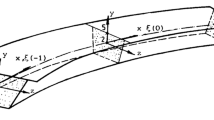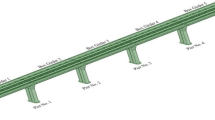Abstract
In this study a full scale 3D analysis of post-tensioned box section and pre-tensioned inverted T-girder section is carried out by considering only vertical loadings. The aim of this research is to investigate long span box Girder Bridge with pre-tensioned inverted T-girder using splicing technique. 4 lanes of 150m long (3 spans @ 50 m) post-tensioned box girder bridge with 12 cells and 13.54 m wide deck is considered as the bridge model and that the equivalent box section consists of 13 numbers of inverted pre-tensioned girder having two different lengths spliced at the points of inflection of continuous length of the bridge. The inverted T-girders are used to support the deck panel with superimposed load on it. The structural analysis of the bridge is done using CSi Bridge employing Integrated 3D Bridge Design Software based on finite element method for both longitudinal and transverse direction. In the analysis, AASHTO LRFD-2006 is used by subjecting Uniformly Distributed Load (UDL), edge loads, knife edge loads, and heavy vehicles load on the bridge deck. Moving vehicles load is placed at different locations to determine the maximum and minimum moments, stresses and flexural effects. Actual post-tensioned box section flexure, shear, torsion and stress in both longitudinal and transverse analyses showed lower values when compared to pre-tensioned inverted T-girder section. Assuming monolithic behaviour, the actual box section provided better stiffness rather than equivalent one. Nevertheless composite behaviour of the equivalent section can be accepted as an alternative solution for long span continuous box Girder Bridge where cost is a major factor in particular.
Similar content being viewed by others
References
Ambare, S. and Peterman, R. J. (2006). Evaluation of the inverted tee shallow bridge system for use in Kansas, Manhattan, Kansas.
Hendy, C. R. and Iles, D. C. (2010). “Steel bridge group: Guidance Notes on best practice in steel bridge construction.” Steel Bridges, No. 5, pp. 185.
Kamel, M. R. and Derrick, D. (1997). “A precast alternative for bridge slabs.” Concrete International, Vol. 19, No. 8, pp. 41–42.
Kamel, M. R. and Derrick, D. (1996). “The inverted tee shallow bridge system for rural areas.” PCI Journal, Vol. 41, No. 5, pp. 28–43.
Kim, K. S. and Yoo, C. H. (2006). “Effects of external bracing on horizontally curved box girder bridges during construction.” Engineering Structures, Vol. 28, No. 12, pp. 1650–1657, DOI: 10.1016/j.engstruct. 2006.03.001.
Rim M. Noureddin (2006). Post-Tensioning the Inverted-T Bridge System for Improved Durability and Increased Span-To-Depth Ratio. (Doctor of Philosophy), Kansas State University, Manhattan, Kansas.
Schlaich, J. and Scheef, H. (1982). Concrete Box-girder Bridges: International Association for Bridge and Structural Engineering.
Tayşi, N. and Özakça, M. (2002). “Free vibration analysis and shape optimization of box-girder bridges in straight and curved planform.” Engineering Structures.
Author information
Authors and Affiliations
Corresponding author
Rights and permissions
About this article
Cite this article
Murad, M.O.F., Chik, Z., Mustafa, A. et al. A comparative study between structural properties of pre-tensioned inverted T-girder and actual post-tensioned box girder in bridge construction. KSCE J Civ Eng 20, 2403–2409 (2016). https://doi.org/10.1007/s12205-016-0657-4
Received:
Revised:
Accepted:
Published:
Issue Date:
DOI: https://doi.org/10.1007/s12205-016-0657-4




